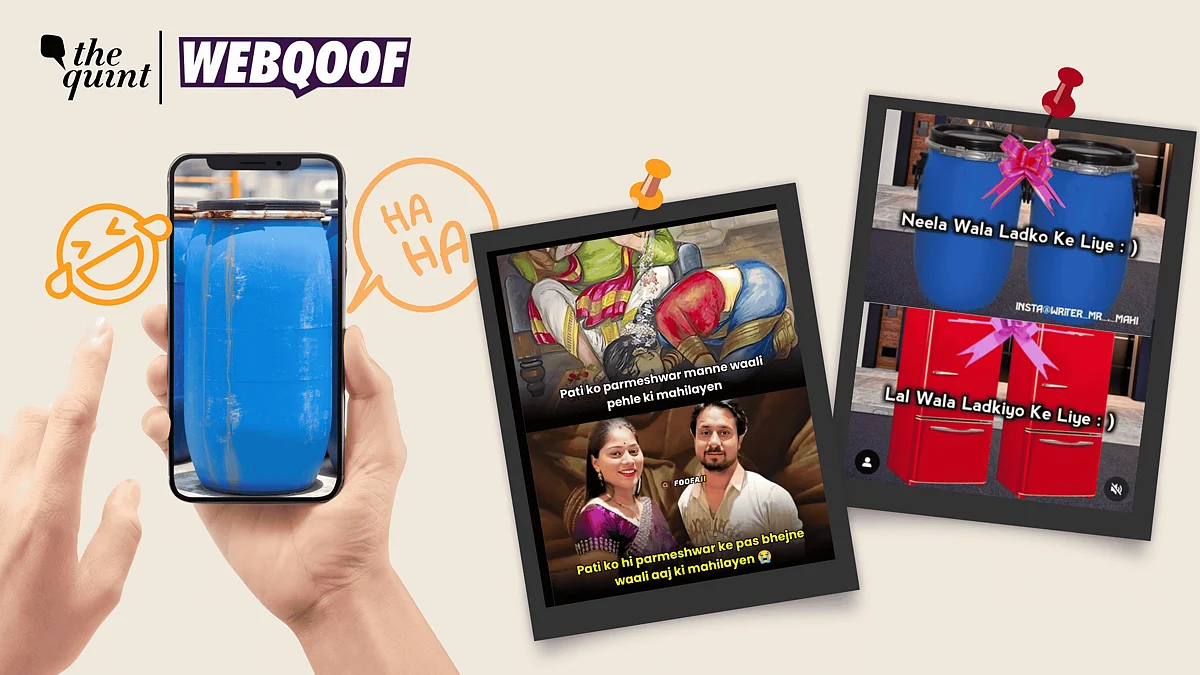From Blue Drums to Fridge Jokes: How Meme Culture Is Turning Violent and Sexist
Is joking about serious crime cases okay? Let's read about this topic in depth.

advertisement
What happens when a gruesome crime becomes the internet’s favourite joke? In India’s meme factory, violence against women or by women is no longer just news. It’s meme content.
From blue drums to body dismemberment, meme culture is now riding on the back of murder trials, often with a misogynistic twist.
Let’s take two recent cases. On 9 June, Meghalaya Police arrested four people, including “kidnapped” Sonam Raghuvanshi (24), wife of Indore tourist Raja Raghuvanshi (29). Raja was allegedly murdered by men reportedly hired by Sonam.
Back in March, another chilling case: Saurabh Rajput (29) was allegedly killed by his wife Muskan Rastogi (27) and her alleged partner Sahil Shukla in Meerut, Uttar Pradesh. Rajput was reportedly drugged, stabbed multiple times, and his body cut into 15 pieces — later stuffed in a blue plastic drum filled with cement.
That blue drum became a meme template.
The details of these cases caused a stir on the internet as reactions came dropping in. While most were shocked, some started creating "funny" content with a hint of insensitivity.
But why are we talking about the memes?
Because memes aren’t just jokes anymore, they're tools for virality. Likes, shares, and views activate the brain’s reward system, as per a recent study, making it harder to resist posting, even when the content is rooted in real tragedy.
Social media trends keeps changing according to news, this can include news about celebrities, movies, new songs, cultural events but now it has also included crime.
Crime is content. And when the accused is a woman, many users see an opportunity to cash in on outrage or reinforce gender biases.
In Raghuvanshi’s case, users are latching onto one idea: that women are dangerous, even murderous. The discourse skips past facts and lands directly into misogynistic tropes.
Another trending song was also turned into a crime news related-meme.
Others are also linking the two cases to create a more malignant cloud of information while sharing memes targeting women and resurfacing the old meme of 'Sonam bewafa hai'.
We also came across several different cases from all across India where groom's friends gifted the newly wed, a big blue drum.
"It’s Meme Now, Not News"
We reached out to Prarthana Mitra, Project Anchor, The Digital Everyday at Point of View (POV), a non-profit related to gender, sexuality and technology. They explained how memes have become a powerful tool to communicate complex stories and issues in a simple manner.
Trolling and makes memes about crime cases not only trivialises the crime but also lacks empathy all while disrespecting the victim and their family.
We noticed such content received a bag of mixed reactions, while some users called it 'funny and entertaining', others termed it as insensitive.
Gendered Disinformation: Targeting Women Online
This isn’t just about memes—it’s about targeting a gender.
From fridge jokes (referencing real cases where women's bodies were found in fridges in Delhi, Bengaluru and Dewas) to posts that suggest men are now scared to marry, the humour relies on fear—and blame—of women.
Several posts and comments highlight a sense of revenge, for example, this comment.
This is the power of social media; the memes and the trolling is no more a harmless piece of content but a creative way of influencing minds, especially the younger generation.
Archive can be seen here.
The motive behind making these reels is either of the two, going viral online or present themselves as a "dominant" gender who should be feared.
These videos usually show men after they have 'killed' girlfriends or wives over an argument or demand and this glorifies violence against women, contributing to a culture of misogyny and harm. This type of behaviour not only normalises abuse but also perpetuates dangerous attitudes in the minds of the viewers.
POV's research has shown that the use of harmful stereotypes, generalisations, and sensationalised narratives is an essential part of most instances of gendered disinformation. This includes instances whether it’s perpetuated with bot accounts to vilify a female politician/journalist, or with memes and deepfakes to vilify a woman accused of murdering her husband.
Women also become a target of disinformation in many cases, noticing a woman raising her voice is often met with misogynistic slurs, fake news about her or even rape and death threats.
Mitra stresses on how it is important to demand more accountability from the government and tech platforms to further prevent hateful content from spreading.
Social Media Becomes a News Source
Social media is increasingly the primary news source for young users. But this shift comes with its own dangers, particularly how it shapes perceptions of gender and violence.
A study published in 2024 found out that gendered and sexualised disinformation, along with virtual violence, is strategically employed to undermine women. This, in turn, is used to delegitimise their political views and tag them as 'immoral', especially Hindutva ideology.
Social media users are not the only ones sensationalising this crime, news media outlets like News Nation who are uploading videos where their reporters are trying to fit inside a similar drum, so "showcase" how this alleged murder must have taken place.
Social media may thrive on trends. But some stories—especially ones involving loss, violence and trauma—deserve restraint. And responsibility.